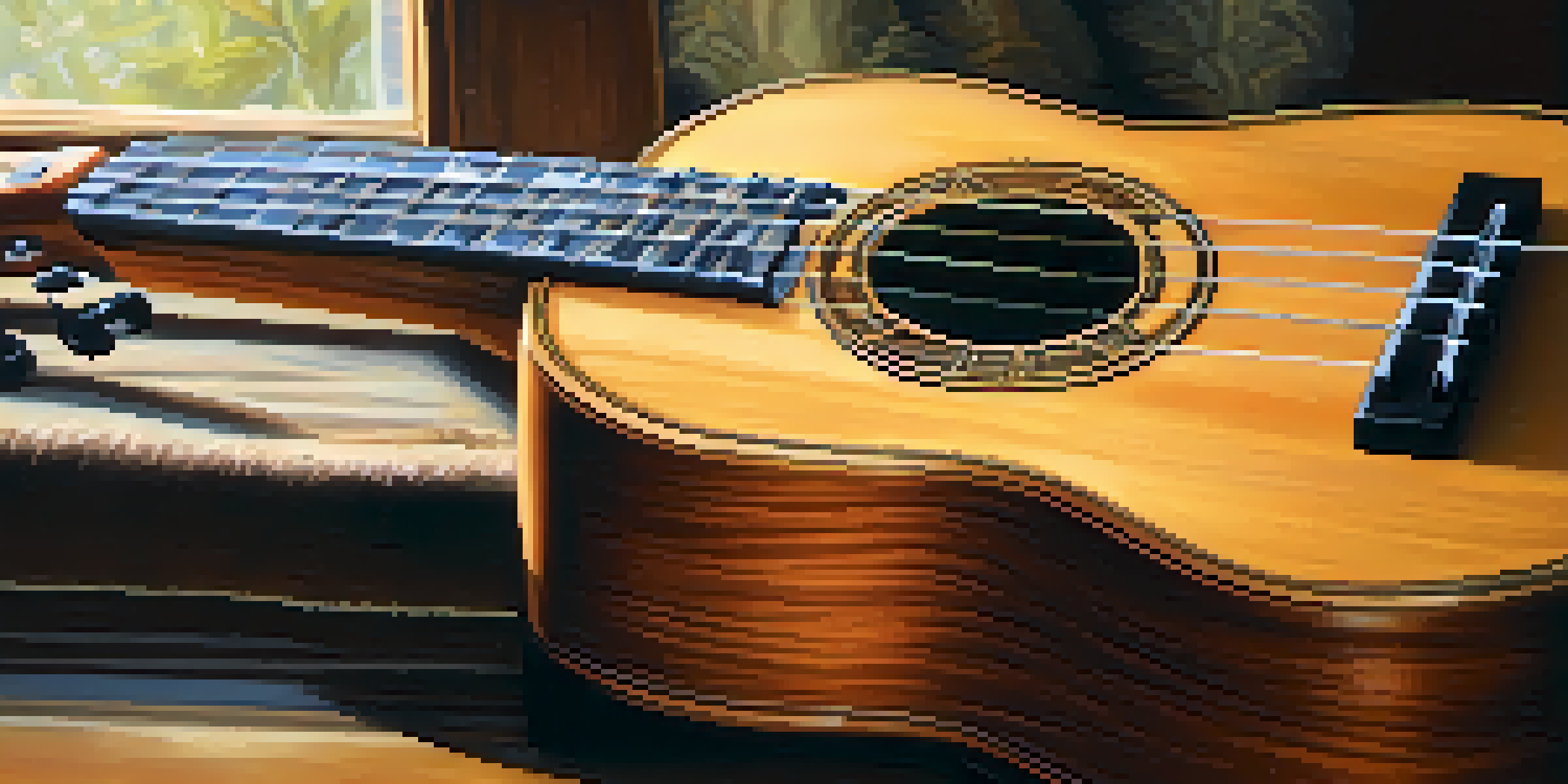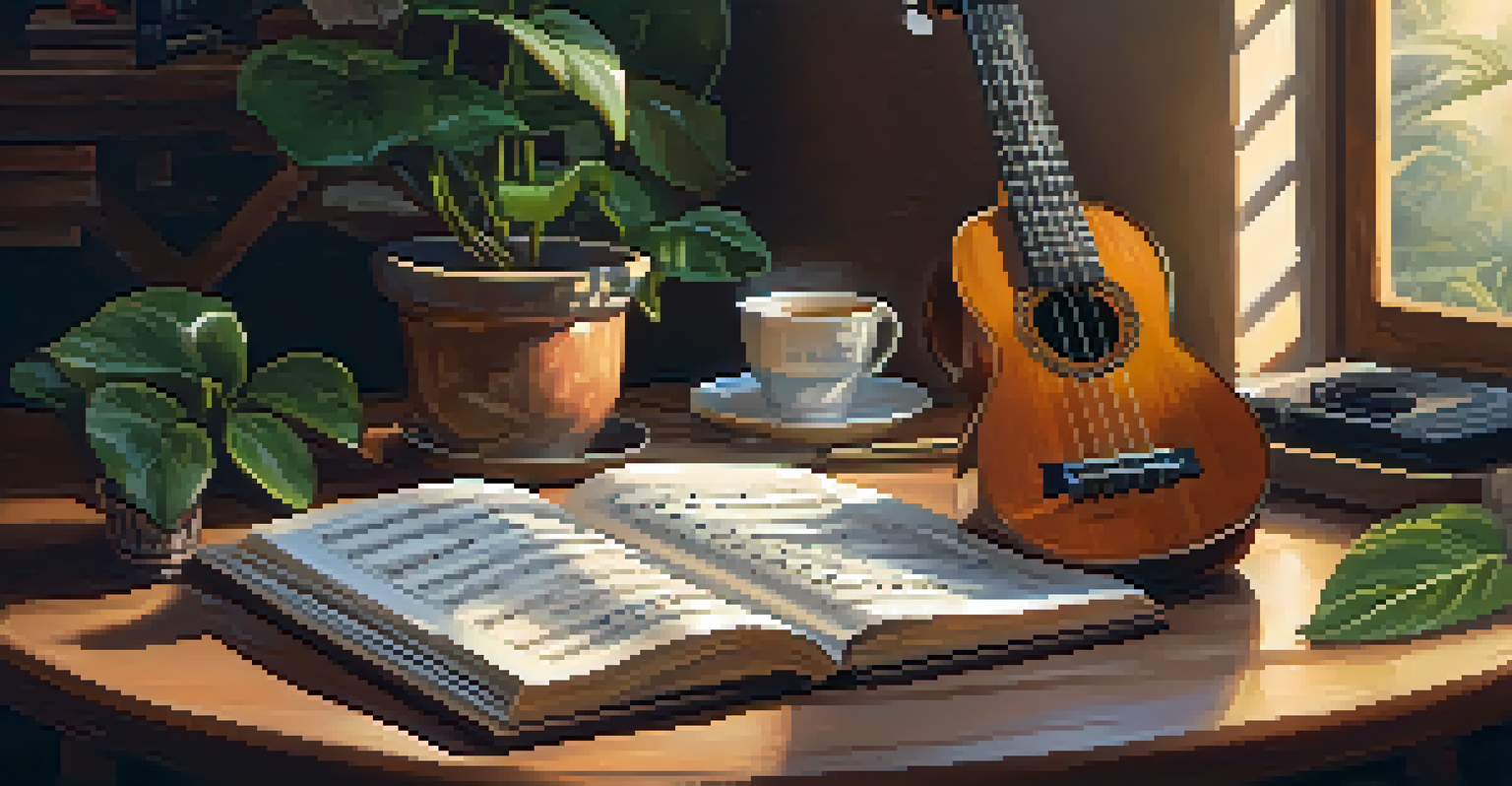Mastering Harmonics on the Ukulele: Techniques and Tips

Understanding Harmonics: The Basics for Ukulele Players
Harmonics are unique musical notes created by lightly touching the strings of your ukulele. Unlike regular notes produced by pressing down the strings, harmonics rely on the vibration of the string without full pressure. This technique adds a delicate, ethereal quality to your music, allowing you to explore new sonic landscapes.
Music is the shorthand of emotion.
To get started, locate the harmonic nodes on your ukulele strings. Common nodes are found at the 5th, 7th, and 12th frets. By gently touching the string at these points while plucking, you'll create a clear, bell-like sound that is distinctive and beautiful.
Understanding the basics of harmonics sets the foundation for more advanced techniques. Once you grasp how to produce these sounds, you can incorporate them into your playing style, making your performances more dynamic and engaging.
Essential Techniques for Playing Harmonics on Ukulele
To successfully play harmonics, one crucial technique is mastering the right touch. Instead of pressing down hard on the string, lightly touch it at the designated fret while strumming or picking. This precision is key; too much pressure will mute the harmonic sound, while too little will produce a dull note.

Another effective technique is using your thumb or finger to pluck the string while your other hand lightly touches the harmonic node. This dual action creates a clear separation between the harmonic and the fundamental pitch, enhancing the overall sound. Practicing this coordination will significantly improve your harmonic play.
Mastering Harmonics for Depth
Learning to play harmonics enhances your ukulele skills, allowing for a more dynamic and engaging performance.
Regular practice of these techniques will help you develop muscle memory, making it easier to incorporate harmonics into your playing. Over time, you'll find yourself effortlessly transitioning between standard chords and harmonics, enriching your musical expression.
Exploring Different Harmonic Patterns on the Ukulele
Once you're comfortable with the basics, it's fun to explore various harmonic patterns. A simple yet effective exercise is to alternate between plucking a harmonic and a regular note. This creates a contrast that captivates listeners and adds depth to your playing.
The beautiful thing about learning is that no one can take it away from you.
Another engaging pattern is the use of harmonics in melodies. Try incorporating harmonics from the 12th fret into your favorite songs. For example, if you're playing a melody that hits a note at the 12th fret, replace it with the harmonic for a sparkling effect that stands out.
Experimenting with different patterns not only enhances your skills but also sparks creativity. The more you play around with harmonics, the more you'll discover unique sounds that can define your musical identity.
Enhancing Your Sound: Effects and Techniques for Harmonics
To further enhance the sound of harmonics, consider using effects pedals. Reverb and delay can create an atmospheric layer to your harmonics, making them ring out beautifully. These effects can transform a simple harmonic into a lush soundscape, perfect for solo performances or recordings.
Additionally, experimenting with different strumming techniques can yield fascinating results. For instance, try using fingerstyle instead of a pick to produce a softer, more nuanced harmonic sound. Each technique brings its own character to the harmonics you create.
Avoid Common Harmonic Mistakes
Being mindful of common mistakes, like applying too much pressure or incorrect plucking, can significantly improve your harmonic playing technique.
These enhancements not only elevate your sound but also allow you to express your musical personality. As you explore various effects and techniques, you'll find unique ways to make your harmonics shine.
Common Mistakes to Avoid When Playing Harmonics
One of the most common mistakes when trying to play harmonics is applying too much pressure on the strings. This can result in muted or unclear sounds, which can be frustrating for beginners. Remember, the goal is to lightly touch the string at the right spot without pressing it down fully.
Another mistake is failing to pluck the string correctly. If you’re not using a clean strum or pluck, it can lead to a dull harmonic sound. Focus on your technique and ensure that your strumming hand is producing a clear note while your fretting hand is lightly touching the string.
Being aware of these common pitfalls will help you progress more quickly. With practice and attention to detail, you can avoid these mistakes and develop a stronger harmonic playing technique.
Incorporating Harmonics into Your Ukulele Playing Style
Incorporating harmonics into your playing style can elevate your music to new heights. One approach is to use harmonics as a transitional element in your songs, creating a seamless flow between different sections. This adds interest and keeps your audience engaged.
For instance, if you're playing a verse, consider transitioning to a harmonic section before moving into the chorus. This not only highlights the harmonic sound but also gives your music a unique structure that stands out.
Resources for Learning Harmonics
Utilizing online tutorials and joining ukulele communities can provide valuable support and motivation in mastering harmonics.
Ultimately, integrating harmonics into your style allows for greater expression and creativity. The more you practice, the more comfortable you'll become with using them, enabling you to craft music that truly resonates with listeners.
Resources and Tools for Mastering Ukulele Harmonics
To master harmonics on the ukulele, utilizing various resources can be incredibly helpful. Online tutorials, videos, and courses can provide visual and auditory examples, making it easier to grasp the concepts. Websites dedicated to ukulele enthusiasts often feature lessons specifically focused on harmonics.
Additionally, consider joining online forums or local ukulele clubs where you can connect with other players. Sharing tips and experiences with fellow musicians can provide valuable insights and motivate you to keep practicing your harmonic skills.

Finally, don't forget about practice tools like metronomes and backing tracks. These can help you develop timing and rhythm while you work on incorporating harmonics into your playing, allowing you to hone your skills in a fun and engaging way.